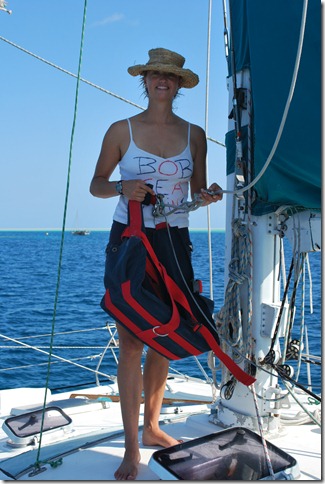Lat: 11 15.043′ S
Long: 120 37.122′ E
Getting to Ashmore involved just what the locals and cruising guides predicted: lots of motoring. We ran the engine about 90% of the way from Darwin to Ashmore, a ridiculous amount of motoring for us. Most of the time we could have sailed if we wanted to, but would only have been making 2-2.5 knots, which makes the 450 nm trip much longer than we were hoping. With the light winds came calm seas, so the passage was pretty comfortable and we were even able to get a few boat projects done. I’m really hoping to spend as much time as possible in Bali enjoying the place instead of doing boat work. We’re currently planning a 2 week stay, which would give us enough time to get off the boat and tour the island a bit.
The daily fly-overs and radio contacts with Australian Customs have continued. These guys are really something else. They’re friendly enough, but I can’t imagine the fuel bills for patrolling the Timor Sea. Speaking of seas, we’re still west of the Indian Ocean proper, so we’ve been passing though all sorts of straits and seas and gulfs. After spending over a year in the Pacific Ocean, we’ve now crossed the Coral Sea, Torres Strait, Endeavor Strait, Gulf of Carpenteria, Dundas Strait, Van Demien Gulf, Clarence Strait, Beagle Gulf, Timor Sea, etc. in a couple of months. It will be nice to be in the broad expanses of an ocean again where it’s simple to remember where you’re at.
Ashmore Reef has a few small sandy islands, but is mostly shallow reef and lagoons. It’s almost halfway between Darwin and Bali and not far off the rhumb line, so it makes a nice place to break up the trip. It’s a strictly managed marine reserve, and most of it is off-limits to the public, but there are some moorings. There’s also the Australian ship the Ashmore Guardian stationed there to monitor things and while we were there, a second larger Australian customs ship, the Triton, was cruising back and forth outside the entrance to the lagoon. As it’s only 100 nm from Timor, Ashmore is apparently a popular destination for refugee boats.
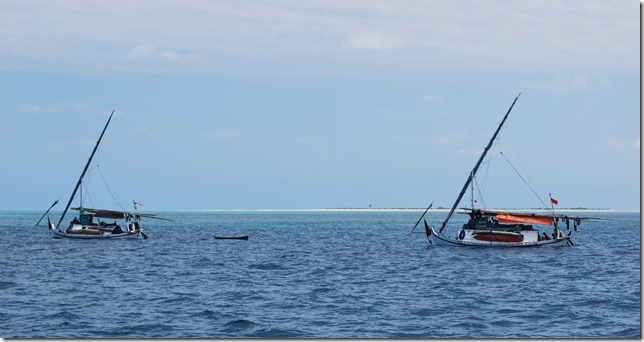 Indonesian fishing boats anchored at the pass into the main lagoon
Indonesian fishing boats anchored at the pass into the main lagoon
We made it to Ashmore with plenty of sunlight left and passed several traditional Indonesian vessels as we motored into the lagoon. They’ve been coming to Ashmore for hundreds of years and are still allowed to stop there to rest and to collect sea cucumbers and trochus shells. The wooden sailboats with dugout canoes as tenders and lateen rigs that are thousands of years old were really a sight to see. As soon as we moored in the inner lagoon and had a cold drink (running the engine gives us enough juice for the freezer), I took Lauren up the mast to have a look around and take some pictures. It was only her second time to go up and it was really a great spot, with beautiful lagoon views. Within seconds of being at the top of the mast, she spied a large sea turtle off to port and then later spotted a group of 8-9 spotted eagle rays swimming off to port as well. One of the Indonesian fishing boats moored next to us set sail and we yelled back and forth to them (Lauren yelling from above) as they passed in front of us. As they came directly upwind, I could catch the smell of a cooking fire burning aboard and see that the man at the helm was working a large wooden tiller, very similar to the one on the traditional Polynesian craft that we’d seen last year in Aitutaki. It was really something to see the ancient technology still being used to make a living today.
Lauren getting ready to go up the stick 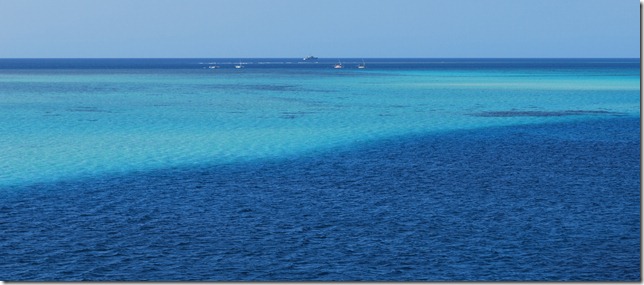
A view back toward the pass with the customs boat Ashmore Guardian moored in the background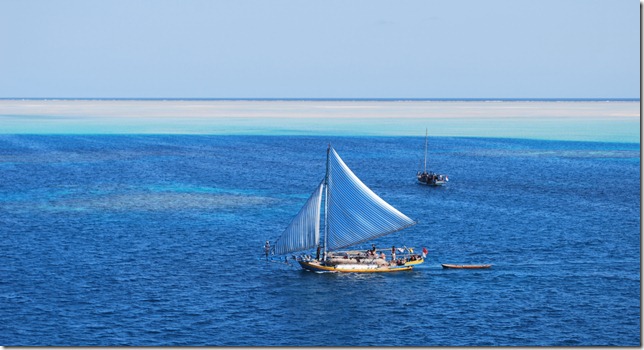
Traditional fishing boat. Check out the guy on the bowsprit to spot coral heads. 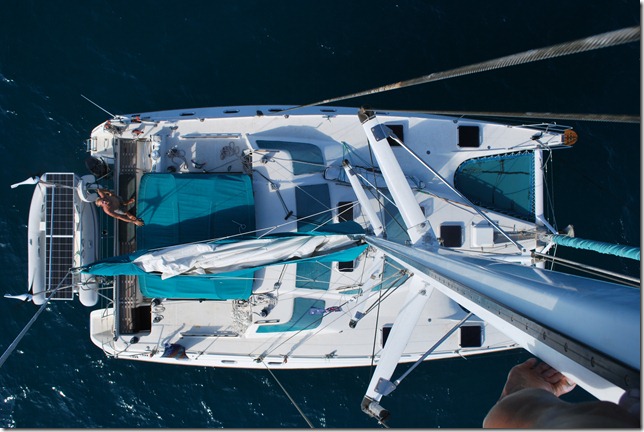 The old girl looks pretty good from a distance…
The old girl looks pretty good from a distance…
It’s been weeks since we’ve been able to get in the water, because to swim in northern Australia is to risk being dragged under by a large croc and never seen again. It felt so good to jump in during the hot afternoon and be floating in the cool water. We were told by the customs boat that scuba diving without a permit wasn’t allowed, so we donned our snorkeling gear and headed for the nearest large coral head. The snorkeling was pretty impressive, and I’m sure we weren’t in the best part of the reef. We swam in a triangle, first to a large coral head off to port, then to a head out in front of the boat, and finally back to the boat. By the time we’d left the second head, we must have seen 5-7 sea turtles of at least two different species, including a pretty large one (about a 4-foot shell). Except for one that was swimming near us, they were all resting on the bottom among seaweed and coral that they seemed to blend in with. It appeared they were just hanging out on the bottom taking a nap. We soon figured out that they were easily spooked (just pointing at one and swimming towards him caused him to speed away) but that their behavior changed if we were calm and just floated above them. Initially they got a little uncomfortable and left their place on the bottom to swim away, but when we just stayed put and floated, they would get curious and actually swim toward us to check us out before heading back toward the bottom.
We saw plenty of beautiful fish (our 2nd underwater cam is on the Fritz, so no pics) including a strange brown and black camouflaged nurse shark of some sort as well as lots of rays with blue spots and tails on the bottom, but our best experience came as we swam back toward the boat. Although the water was beautiful, the visibility wasn’t that great — only 35-40 feet or so when looking down, so we were surprised when we saw a group of large spotted eagle rays swimming across our path from left to right. There were 8 of them swimming in formation with their wings slowly pushing them along. Although they had to be aware of us being there, they just kept on swimming ahead of us for a minute or two, although the one closest to us did circle back a bit to have a better look at us before re-entering the formation. Unlike stingrays, which are usually fairly flat, the spotted eagle rays have a relatively thick mid section and features that come closer to resembling a face. The way they move through the water so gracefully really looks more like flying in slow motion than swimming. It was only the second time we’d seen a spotted eagle ray and to see them all swimming together was definitely one of the coolest things we’ve seen underwater.
Between all the snorkeling and being at sea for several days, it was all we could do to stay up till 9pm, so we went to be early, tired but pretty happy with our current way of life. The next morning we were just starting to get around when a couple of Indonesian fisherman from one of the boats anchored in the pass showed up at our stern in a dugout canoe. The only English they knew was "mister" and "thank-you", and the words and phrases in the Lonely Planet Bali book were great for going to a restaurant or booking a hotel, but they weren’t too great for a chance meeting at sea. In the end, we concluded that one was Hindu and the other Muslim and both were from Bali. We ended up giving them a pair of old fins that needed a repair, a few small pieces of spare line, cups of coffee, and some cold water for the trip back to their boat. They were pretty happy just to hang out and were fascinated by the phrase & translation portion of the Lonely Planet book, but eventually it was time for us to eat breakfast and get ready to go.
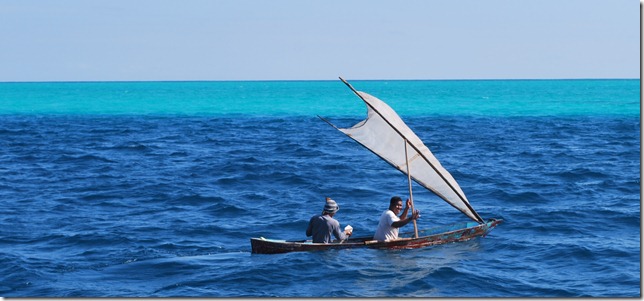 Indonesian fisherman sailing & bailing the dugout canoe. The sail rig is roughly a 2000 year old design.
Indonesian fisherman sailing & bailing the dugout canoe. The sail rig is roughly a 2000 year old design.
We wanted to try to make Bali by Friday to check in before the weekend, and so far it looks like we’ll have no problem. Just as predicted, we started getting good winds just as we got to Ashmore and we’ve had the spinnaker up ever since leaving. At this rate we’ll be in Bali Thursday morning. In addition to picking up good wind, we’re back in deep water again (1000’s of feet). From the Torres Strait to Ashmore, we’ve seldom been in more than 300-400 feet of water and much of the time we’ve been in 200 feet or less. That’s a big change compared to the open ocean and it’s made a big difference in how far out at sea we can be and still feel the currents associated with the tides. Hopefully the steady breeze and calm seas continue. The warm, clear days and starry nights are nice, although a break from the midday heat would be nice, too. We hit 90 degrees in the salon today and there isn’t much of a breeze when we’re sailing downwind like we are now. Oh well, I suppose the heat of the tropical winter still beats August weather back home.


